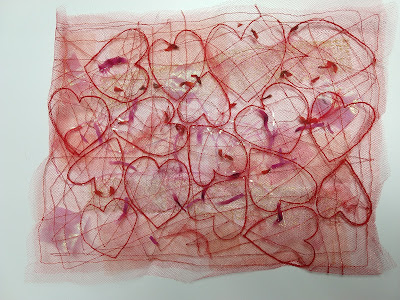I have made 2,662 postage-stamp-size quilts, their polka dots signifying coronaviruses floating around in the air around us, each one marking the death of one Kentuckian to the disease in 2020. That was the easy part. Now it's time to sew them together into a big grid.
But first, arithmetic.
I'm not one for a whole lot of planning before I start a project. Some people may find security in sketching, measuring, samples, templates, junior "etudes" before embarking on the real thing. I find those things unnecessary, time-wasting and anxiety-provoking. I like to get on with it, and let the actual materials tell me how they want to behave, what they want to become, even as we work together.
I did make an attempt to pre-plan this project. I thought I would make my postage stamps 1 1/2 inch wide and 1 1/4 inch tall. So I cut my fabrics into 5 inch strips, planning to eventually slice them into four strips the right height, and then cut the strips into 1 1/2 inch pieces. I made a couple hundred at those dimensions before I realized that they looked too square, and I wanted my bits to be more obviously rectangular. Can't tell you why, they just looked too puny.
Thought about this for a while, and then decided what the heck, let's change the size. A few hundred smaller ones would surely not be apparently among a sea of larger ones, and if they were, so what? People aren't all the same, why should their metaphorical embodiments have to be? So most of the tiny quilts are 1 3/4 inches wide.
But even if you can get away with changing the arithmetic in midstream while making the components, there comes a time in construction where you have to actually commit to a certain number. Namely, how many columns of postage stamps to make, and how many stamps to sew into each column.
Because I had upsized my bits, the full finished size got bigger too, and suddenly I was worried about it being too wide for my good brass rod that I always use to hang big postage stamp quilts. I think I'll end up with about 2 inches per column, with the bits pushed pretty close together. So I'm leaning toward 41 columns of 64 bits each, plus one extra column of 38. Or something like that.
I don't have to decide until I sit down to sew, and that can't happen until I clean off my sewing table and transform it into a huge, smooth, obstacle-free surface with no cracks or corners to impede the movement of the stitched grid. A few days to think -- and then maybe I'll just flip a coin.

















